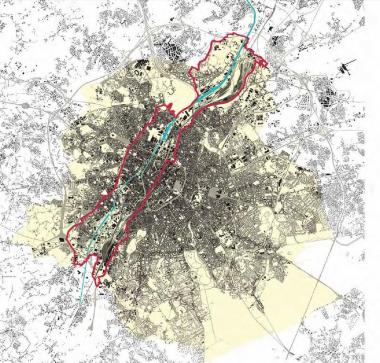
2012-02-27 - The Brussels-Capital Region has launched an international competition for the development of a master plan for the canal area, as important urban planning, socio-economic and demographic issues are at stake there. The European call for tenders in July 2011 attracted seventeen candidates, from which three prestigious international and multidisciplinary teams were selected in October 2011 (more information in the attached pdf).
On Wednesday 29 February the three teams will submit their plans, but the municipalities and regional institutions concerned had already been briefed on the details of the procedure and the ambitions of this master plan on this Monday. This initiative is being steered by the cabinet of the Brussels minister-president and supported by the regional administration’s Directorate of Studies and Planning (DSP) and the Agency for Territorial Development (ATO), with the help of an external provider, Architecture Workroom Brussels (AWB).
The selection of the winner is scheduled before summer. After this, the consortium which has been selected will prepare the master plan for the canal over a period of six to nine months. The implementation of the master plan could then be supported for a further three years.
Three first-class teams
The following three multidisciplinary teams have produced a draft master plan:
· Groupement Alexandre Chemetoff & Associés: Alexandre Chemetoff & Associés (lead partner), Idea Consult and Ecorem. Alexandre Chemetoff was involved in the construction of a district of 50,000 homes in Bordeaux, the outline plan for the redevelopment of the Île de Nantes and the master scheme for the Plateau de La Haye in Nancy.
· XDGA: XDGA-Xaveer De Geyter Architecten (lead partner), landscape architect Michel Desvigne, Tritel and Prof. Eric Corijn. XDGA has been involved in the OIN Paris-Saclay campus, the future Watersite district in Vilvoorde and the Saint-Maurice district in Lille.
· Kanal Kanalysator: DeZwarteHond (lead partner), Studio UC, Lola, Movares, Michiel Dehaene and Sofie Vermeulen. De Zwarte Hond and Movares worked on the master plan for the Florijn Axis in Assen; Studio UC and De Zwarte Hond on the restructuring of the industrial zone in Munich; and Lola on the Marstallplatz in Hannover.
Challenges, potential and a vision
The Brussels-Capital Region faces major urban challenges (demographic, economic, social, ecological, territorial, etc.), which also create an opportunity to take a fresh look at the region as a whole and devise an ambitious and coherent planning policy.
The challenges are located mainly in the central part of the Region, on both sides of the canal. The approach requires an integrated plan for land use in this area, leading to a clear, shared vision for this part of the city, which falls within the Regional Sustainable Development Plan currently on the drawing-board (www.prdd-gpdo.be).
For several years, private investment has continued and reinforced the many government initiatives in this area over the past twenty years: district contracts financed by the Region, infrastructure development with support from Beliris(1), dwellings built with the support of the Brussels Regional Development Agency (SDRB), projects supported by the European structural funds, and so on.
A new operational and flexible instrument
There are thus many developments in progress in this high-potential area, but there is still no common plan. This is why a structured urban vision is needed that underpins and complements existing initiatives. The area’s territorial and social cohesion can be improved by developing a long-term urban ambition: a position shared by all the stakeholders and an instrument that combines public and private actions in the short, medium and long term.
To do this, the master plan needs to examine and analyse the area’s capacity for transformation, propose an innovative approach for this transformation, and define the conditions for implementation. It must outline existing and future initiatives for the canal area, monitor coherence between projects and encourage close collaboration between the various players in the area. It must also be set up as a plan that evolves in line with the transformation of the area and the needs of residents.
(1) Cooperation agreement between the federal state and the Brussels-Capital Region for initiatives that support Brussels’ international role and its position as a capital city.















